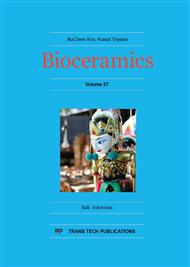p.32
p.36
p.40
p.45
p.51
p.57
p.60
p.69
p.74
Production of Apatite from Snail Shells for Biomedical Engineering Applications
Abstract:
Bioceramics is very important application for dental and orthopedic procedures. Beside all these normal procedures traffic accidents are requiring increasing number of graft, prostheses and orthosis applications. Bioceramics can be produced from local and natural sources with various methods. Those can be produced from various bone structures through calcination (at high temperatures) or with diluted hydrochloric acid (HCl) application & freeze drying. Beside these methods calcite and aragonite structures like from sea shells and egg shells bioceramic production can be realized through mechanochemical processing via a simple hot-plate or ultrasonic equipment. A fresh water snail shell (Zebra Nerite Snail - Neritina natalensis) was prepared as bioceramic production source. The resulting hydroxyapatite (HA) powders were obtained without any impurities. At two varying temperature of 865 and 885 °C the snail shells was transformed to HA bioceramics. Scanning electron microscopy (SEM), X-ray diffraction (XRD) and differential thermal analysis (TG/DTA) were evaluated.
Info:
Periodical:
Pages:
51-56
Citation:
Online since:
May 2016
Price:
Сopyright:
© 2016 Trans Tech Publications Ltd. All Rights Reserved
Share:
Citation:


